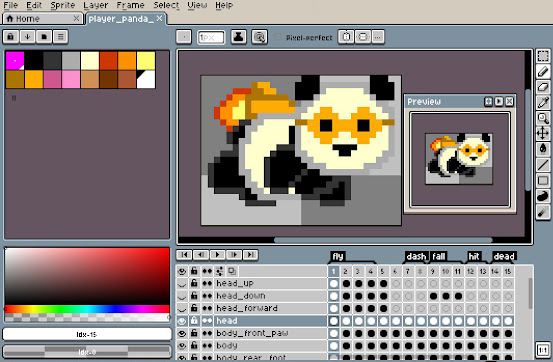Mega Palettes
Ah, the Sega Megadrive, halcyon days. I remember pre-ordering mine from Special Reserve and eagerly awaiting the launch date. They sent me a copy of Super Monaco GP and a second control pad, which I got to stare at for a week before the console itself finally arrived. It was worth the wait. I still own one today.
If you're going to make graphics for a Megadrive game, then you're going to be spending a lot of time with palettes! Aside from the pixel art program Aseprite, the most useful graphics tool I have is a post-it note stuck to the monitor with the numbers 0, 52, 87, 116, 144, 172, 206, 255 written on it.
I am almost exclusively using Aseprite to produce the graphics for Rocket Panda, and occasionally Cinema4D to render any 3d animated objects which then need to be processed through Aseprite. The end result is a series of sprite and tile sheets which are mapped to particular palettes. Creating these palettes is the crux of the operation and has to be nailed down fairly early on, otherwise a lot of work will need re-mapping where any palette is shared.
The Megadrive can use 4 palettes of 16 colours at any time. In each of these palettes index 0 is transparent, but can be shown as a colour if used on the base layer. This means effectively there can be 61 different colours on screen at once. Additional trickery can be used to produce more colours, but as this is our first development using new tools, we are sticking to the basics.
Each of the 64 palette indexes can be assigned one of the Megadrive's 512 different colours. The 512 colours comes from the base rule that any R, G, or B value can only be one of 8 values: 0, 52, 87, 116, 144, 172, 206, 255. Since Aseprite only deals with palettes up to 256 colours, I get to spend a lot of time typing these numbers in! The problem with the jumps between values is that it can be difficult to get a good gradient effect without the hue changing noticeably. This is particularly troublesome at the higher and lower end of the value range. Dithering can help, but early tests produced something that didn't suit the game. Rocket Panda has always had a cartoon cel-shaded look and dithering doesn't fit in with that.
A few of the graphics were adapted from my earlier pixel-drawn mobile
game, Retro Panda Lander, in which I restricted myself to the NES
palette colours. That helped in transferring to the Megadrive. It can be diffcult working under restrictions, but I find it can help make decision making easier as you don't have free reign, as well as throwing up some interesting challenges.



Interesting : ) ! I will look forward to you work.
ReplyDelete*your
Delete